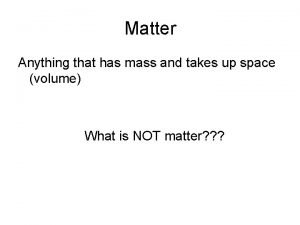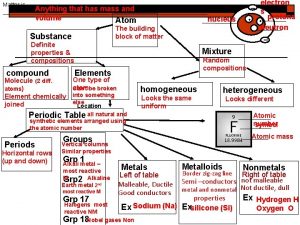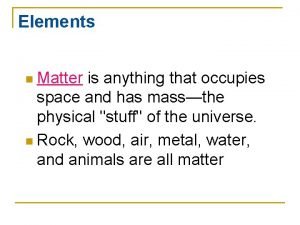Density Matter anything that has mass and takes

















- Slides: 17

Density

Matter: anything that has mass and takes up space Mass: the amount of matter present Weight: the effect of gravity on an object’s mass Volume: the amount of space matter takes up Density: the mass per unit volume of an object

Facts about Density 1. All matter has density 2. Density of a specific kind of matter is a property that helps to identify it and distinguish it from other kinds of matter.

Formulas Density = Mass Volume Mass = Volume x Density Volume = Mass Density is expressed as: g/cm 3 OR g/ml

• Density of wood is 0. 8 g/cm 3 -This means that a one cubic centimeter piece of wood has a mass of 0. 8 grams. • Density of steel is 7. 8 g/cm 3 -This means that a one cubic centimeter piece of steel has a mass of 7. 8 grams.

What does this mean? • Therefore, a piece of steel has a mass of about 9. 75 times that of wood for every 1 cubic centimeter. • Steel is MORE dense than wood.

What about water? • Freezing point of water = 0 degrees Celsius • Boiling point of water = 100 degrees Celsius • Density of water = 1. 00 g/cm 3 – Thus, fresh water has a mass of 1. 00 g for every one cubic centimeter

• Objects with a density LESS than water FLOAT • Objects with a density MORE than water SINK

Why does ice float? 1. Frozen water (ice) is actually less dense than liquid water. 2. Ice is 89% of the density of cold water. 3. This means that only about 11% of a block of ice stays above the surface of the water.

• This fact is what makes icebergs so dangerous. It is only “the tip of the iceberg” that is visible.

How can you make more dense things float in water? • Buoyancy is the ability of a fluid to exert an upward force on an object placed in it. • Buoyancy results in the apparent loss of weight of an object in a fluid.

How does the Buoyant Force work? • Buoyancy allows things to float in water, by opposing the force of gravity.

• When the buoyant force is equal to the weight of the object, the object floats or is suspended. • When the buoyant force is less than the weight of the object, the object sinks.

Archimedes’ Principle • States: The buoyant force on an object is equal to the weight of the fluid displaced by the object. – Submerged object displaces volume of fluid equal to its own volume. – Floating object displaces a volume of liquid equal to the portion that is submerged.

Compared to an empty ship, will a ship loaded with a cargo of Styrofoam float lower in water or higher in water?

• • • Pre-viewing question Why do some objects float and others sink? • Post-viewing question How was the Titanic designed to float in spite of its mass?

Titanic
 Anything which occupies space and has mass
Anything which occupies space and has mass Anything that has mass and takes up space
Anything that has mass and takes up space Anything that has matter and takes up space
Anything that has matter and takes up space Malleability defintion
Malleability defintion Matter vs weight
Matter vs weight Anything that has mass and takes up space
Anything that has mass and takes up space Anything that has mass and takes up space
Anything that has mass and takes up space Matter is anything that
Matter is anything that Matter is anything that has
Matter is anything that has Anything that has mass and volume is
Anything that has mass and volume is Anthing that takes up space and has mass is called?
Anthing that takes up space and has mass is called? Matter is anything that has mass and volume
Matter is anything that has mass and volume Matter is anything that
Matter is anything that Matter is anything that occupies space and has
Matter is anything that occupies space and has It is anything that has mass and occupies space
It is anything that has mass and occupies space It is anything that has mass and occupies space
It is anything that has mass and occupies space Phân độ lown ngoại tâm thu
Phân độ lown ngoại tâm thu Block nhĩ thất độ 3
Block nhĩ thất độ 3




























